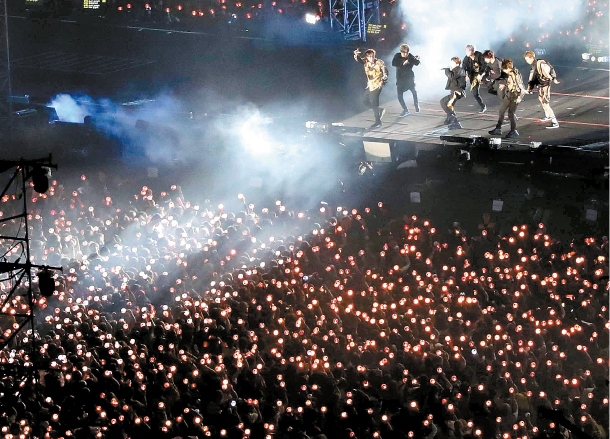
K-Pop Lightsticks
Exploring the Evolution of Korean Protest Culture into K-Pop Lightsticks
Hello! The K-Pop craze is truly incredible these days, isn’t it? But did you know that this phenomenon extends beyond just music and is influencing Korean protest culture as well? Today, I want to discuss this fascinating change. It will be interesting to explore how important lightsticks have become and the background and meaning behind them! So, let’s get started!

The Connection Between K-Pop and Korean Protest Culture
K-Pop and Korean protest culture are connected in various ways, serving as essential elements in forming social interactions and collective identities. K-Pop is built on an enormous fandom, which often coincides with protest culture. Fans gather at events like concerts to express their passion, fostering a sense of community in the process. In this context, lightsticks have become a crucial tool for fans to demonstrate their united strength. Therefore, K-Pop not only influences protest culture but also contributes to shaping the identity and culture of protests. This connection serves as an important indicator of changes and developments in modern Korean society.
The Origin and Development of Lightsticks
The origin of lightsticks dates back to the late 1990s. This culture began when K-Pop idol group fans gathered to cheer, evolving into a means for fans to share their enthusiasm and feel a connection with the idols. Initially, simple flashlights or basic products were used, but with technological advancements, lightsticks with various features began to emerge. Today’s lightsticks come with built-in LED lights and can connect via Bluetooth, offering sound and vibration functions for diverse expressions. This has transformed them from mere cheering tools into platforms for real-time communication, evolving into significant symbols of K-Pop culture.

Examples of Lightstick Use in Protests
Lightsticks are now used in various protests and demonstrations beyond K-Pop concerts. For instance, at rallies opposing specific events, fans can be seen raising their lightsticks while chanting simple slogans in unison. This phenomenon goes beyond mere expression, fostering collective unity and solidarity among participants. The lights and colors of the lightsticks visually convey the emotions of attendees, enhancing the atmosphere of the protest. Thus, lightsticks have become an important element not only within K-Pop fandom culture but also in raising awareness for social issues.
The Various Functions and Technological Innovations of Lightsticks
Lightsticks have evolved into smart items with functions beyond simple cheering tools. The latest lightsticks allow for various LED color adjustments, enabling fans to change the color of their lightsticks to align with specific songs or performances, expressing a sense of unity. Additionally, some lightsticks are linked to smartphone applications that facilitate real-time interaction between fans and idols. These technological innovations enable fans to play a role as part of the performance, strengthening their bond with the idols. Thus, the evolution of lightsticks opens new dimensions to the K-Pop fan experience.

The Impact of Lightsticks in Conveying Social Messages
Lightsticks have now established themselves as powerful media for conveying social messages beyond being mere cheering tools. For example, fans may simultaneously raise lightsticks of specific colors to express support for particular issues or chant slogans containing social messages. These activities serve as means of representing collective opinions, delivering powerful messages to the public. Especially when K-Pop fandoms gather on a large scale, the lightsticks they use draw attention to specific social issues, acting as catalysts for change. Therefore, lightsticks function as important communication tools in modern Korean society, fostering a sense of social responsibility.

Comparison with Protest Cultures in Other Countries
The integration of Korean protest culture with K-Pop lightsticks possesses unique characteristics when compared to protest cultures in other countries. For example, protests in the United States tend to focus more on direct political messages or slogans, whereas in Korea, collective expression through lightsticks and fandom culture is more pronounced. Other Asian countries also have strong protest cultures, but the format of protests involving K-Pop fandom is creating their own unique culture. These differences illustrate how the symbolism of lightsticks in protests varies according to each country’s cultural background and social context.

The Future Role of Lightsticks in Korean Protest Culture
The future of Korean protest culture is expected to evolve further with advancements in technology. The use of lightsticks will expand beyond K-Pop concerts to respond to a wider range of social issues. This change may encourage more people to participate in protests, especially among younger generations, establishing a new way of social engagement. Lightsticks are projected to play a role in conveying social messages beyond just being symbols of fandom. Moreover, as technological innovations continue, the emergence of various forms of lightsticks is likely, enriching the protest culture in diverse ways.

Cultural Change and the Symbolism of Lightsticks
Lightsticks have now become important elements symbolizing cultural change in Korean society, transcending their role as mere tools for K-Pop fans. In the past, K-Pop culture maintained a distance from neutral or political news, but now it is intertwined with social issues, allowing fans to voice their opinions through lightsticks. This change reflects the social responsibility and engagement of K-Pop fandom, marking a significant moment for lightsticks to become true symbols of the era. Moving forward, the role and symbolism of lightsticks will reflect changes in Korean society and play a crucial role in drawing attention to various social issues.



